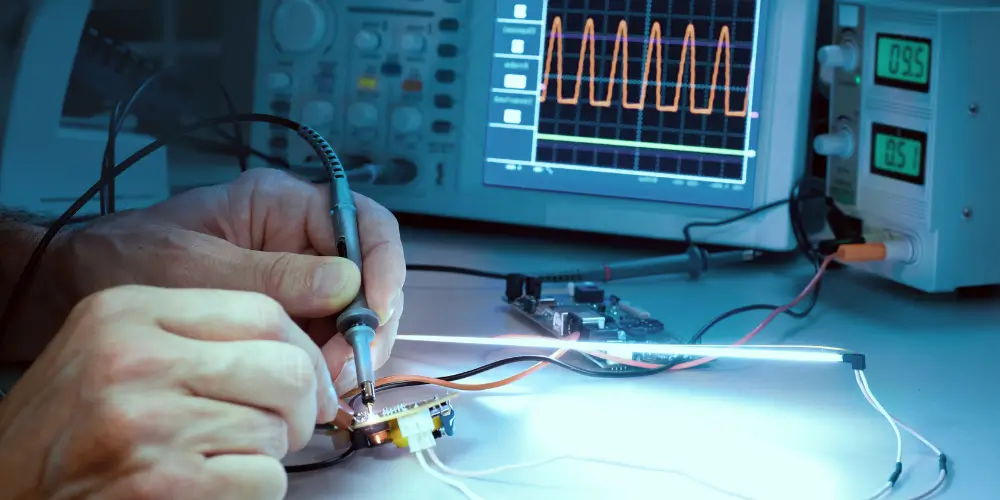PAT testing isn’t a legal requirement for us as landlords, but we’re still responsible for ensuring any electrical appliances we supply are safe and well maintained, in line with regulations like the Electrical Equipment (Safety) Regulations 2016. While regular PAT testing isn’t mandated by law, it’s a recognised way to demonstrate our commitment to electrical safety and manage liability. Understanding the distinctions between PAT testing and other safety checks can help us meet our legal responsibilities confidently.
Key Takeaways
- PAT testing is not a legal requirement for landlords in the UK, but appliances must be safe and maintained.
- The law requires landlords to ensure all provided electrical appliances are safe for tenant use.
- Regular PAT testing is considered best practice and helps demonstrate a proactive approach to safety.
- Documented appliance checks can reduce landlord liability and support insurance claims in case of incidents.
- Non-compliance with general electrical safety standards can lead to penalties, regardless of PAT testing status.
Table of Contents
Understanding PAT Testing and Its Purpose
Portable Appliance Testing (PAT) plays an essential role in ensuring the electrical safety of appliances we provide within rental properties. As landlords, we must grasp pat testing basics to uphold appliance safety standards and meet our landlord obligations. PAT testing involves a systematic process: visual inspections and instrument-based checks confirm an appliance’s integrity and functionality. Through this, we proactively identify risks associated with faulty plugs, damaged wiring, or insulation failures—key electrical safety measures for tenant protection. While not every appliance legally requires testing, regular PAT assessments demonstrate a commitment to high safety standards, reducing potential liability. By integrating these checks into our property management routines, we maintain a safer environment and reinforce compliance with broader safety expectations, safeguarding both tenants and our reputations.
Key Legislation Governing Electrical Safety in Rental Properties
Although electrical safety in rental properties is governed by several key regulations, we must pay particular attention to the Electrical Safety Standards in the Private Rented Sector (England) Regulations 2020. This legislation mandates that landlords guarantee all electrical installations meet key safety standards throughout a tenancy. We’re required to conduct thorough electrical risk assessments at regular intervals, guaranteeing tenant safety obligations are met and documented. These assessments also underpin robust appliance maintenance guidelines, driving consistent compliance.
Here’s a concise overview of the principal regulatory requirements:
| Regulation/Guideline | Focus Area | Compliance Frequency |
| CircElectrical Safety Standards (England) Regulations 2020 | Fixed electrical systems | Every 5 years |
| The Landlord and Tenant Act 1985 | General safety obligations | Ongoing |
| HSE Electrical Safety Guidance | Appliance maintenance | As recommended by HSE |
Remaining current with these standards is essential for legal compliance and tenant protection.

What the Law Says About PAT Testing for Landlords
While electrical safety in rental properties is strictly regulated, current UK law doesn’t impose an explicit legal requirement for landlords to carry out PAT (Portable Appliance Testing) on electrical appliances provided within a rental property. However, we mustn’t fall for PAT testing myths—regulations such as the Electrical Equipment (Safety) Regulations 2016 and the Landlord and Tenant Act 1985 stress the need for safe appliances, but they stop short of mandating PAT testing itself. Instead, they require us to guarantee appliances are safe and well maintained, aligning with tenant rights to a secure home. Applying rigorous electrical safety tips and best practices for appliance maintenance remains crucial. Ultimately, while PAT testing isn’t legally compulsory, demonstrating due diligence in electrical safety management is essential for regulatory compliance.
Landlord Responsibilities for Electrical Appliance Safety
Even though UK law doesn’t specifically require PAT testing, we must still guarantee all electrical appliances we provide are safe and maintained throughout a tenancy. Our landlord obligations under the Electrical Equipment (Safety) Regulations 2016 and the Landlord and Tenant Act 1985 demand a proactive approach to tenant safety. This means conducting regular appliance maintenance and robust risk assessment for every item we supply—from kettles to washing machines. We should document inspection dates, note any faults, and promptly resolve identified risks to prevent hazards. It is crucial to keep records as proof we’ve fulfilled our duties. Ultimately, our commitment to tenant safety isn’t just best practice—it’s a legal expectation, and thorough risk assessment is a cornerstone of responsible property management.
Differences Between PAT Testing and Other Electrical Inspections
Because electrical safety involves several compliance checks, it’s important we comprehend how Portable Appliance Testing (PAT) differs from other electrical inspections required for rental properties. PAT testing focuses specifically on the condition and safety of portable electrical appliances, verifying they meet safety standards through visual examination and functional testing. In contrast, routine electrical inspections, such as Electrical Installation Condition Reports (EICR), assess the fixed wiring, circuits, and distribution boards within the property. These inspections address the integrity and compliance of the entire electrical installation rather than individual appliances. Both are essential compliance measures, but PAT testing targets plug-in devices, while electrical inspections evaluate the broader infrastructure. Understanding this distinction helps us guarantee we fulfill all regulatory obligations and maintain a robust approach to electrical safety in our properties.
Benefits of Regular PAT Testing in Rental Properties
Although PAT testing isn’t a legal requirement in itself, implementing regular PAT testing in rental properties delivers significant advantages for both landlords and tenants. By systematically verifying the safety and functionality of portable electrical appliances, we achieve robust safety assurance, directly reducing the likelihood of electrical faults or hazards. This proactive approach to risk management not only safeguards occupants but also demonstrates our commitment to maintaining high standards, which enhances tenant satisfaction and trust. Additionally, documenting regular PAT testing can positively influence property value, as it evidences diligent management and attention to detail during inspections or sales. Ultimately, integrating PAT testing into our maintenance routines reflects our professionalism, supports compliance with broader electrical safety regulations, and helps to build long-term, positive relationships with tenants.
Penalties and Risks of Non-Compliance
While regular PAT testing offers clear advantages in rental properties, we must also consider the consequences of neglecting our responsibilities around electrical safety. Failure to comply with regulations exposes us to significant penalties for negligence, including prosecution under the Electrical Equipment (Safety) Regulations and the Housing Act. These statutory breaches may result in fines, criminal records, or prohibition notices. Beyond legal sanctions, safety compliance risks directly impact our risk profile; insurers may void policies or refuse claims linked to untested appliances, leading to severe insurance implications. Additionally, if tenants suffer injury or property loss due to faulty appliances, tenant liability concerns escalate, opening us up to civil claims and reputational damage. Proactive compliance is essential for safeguarding our interests and maintaining professional standards in property management.

Best Practices for Managing Appliance Safety in Your Rentals
To guarantee robust compliance with electrical safety regulations, we must implement a systematic approach to managing appliance safety in our rental properties. Establishing rigorous appliance maintenance protocols is crucial; this means logging all inventory, conducting initial and periodic inspections, and guaranteeing timely repairs or replacements. We should develop clear inspection schedules, aligning with manufacturer guidance and statutory requirements, to minimise risk and maintain documentation for regulatory review. Effective tenant communication is equally essential—providing tenants with information about appliance usage, reporting procedures for faults, and access to guidance guarantees awareness and rapid response to issues. Additionally, we must invest in safety training for both staff and tenants, focusing on hazard recognition and emergency protocols. Together, these practices create a robust, compliant safety culture.
Frequently Asked Questions
Who Is Qualified to Carry Out PAT Testing in Rental Properties?
We must guarantee only qualified professionals, who’ve completed a recognized certification process, conduct PAT testing in rental properties. Adhering to testing standards is essential, aligning with landlord responsibilities to ensure tenant safety and maintain regulatory compliance at all times.
How Much Does PAT Testing Typically Cost for Landlords?
When we estimate PAT testing costs, we consider cost factors like property size, appliance types, and testing frequency. As landlords, our responsibilities include ensuring compliance, so precise pricing depends on the number and complexity of appliances tested.
How Often Should Landlords Update PAT Testing Records?
We should update PAT testing records according to frequency guidelines—typically annually or after compliance checks. Accurate record keeping guarantees we meet safety standards, document all inspections, and demonstrate regulatory compliance during audits or when queried by authorities.
Can Tenants Request PAT Testing for Specific Appliances?
As tenants, we’ve the right to raise appliance safety concerns. Landlords must address these under their responsibilities. We can initiate the request process in writing, citing tenant rights and specifying which appliances require PAT testing for compliance.
Are PAT Testing Certificates Required for Property Insurance Claims?
When we handle insurance claims, insurers often assess our adherence to safety regulations and landlord responsibilities. While PAT testing certificates aren’t always mandatory, maintaining electrical compliance with documentation can strengthen our position and demonstrate proactive risk management.
Conclusion
In conclusion, while PAT testing isn’t explicitly required by law for landlords, we’re still legally obligated to guarantee all electrical appliances in our properties are safe. Conducting regular PAT testing helps us meet our duty of care, demonstrate compliance with key regulations, and protect both tenants and our investments. By staying proactive and thorough with appliance safety, we minimize risks, avoid penalties, and uphold the highest standards in property management. Let’s always prioritize safety and compliance.
